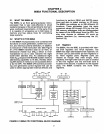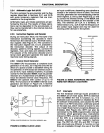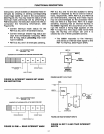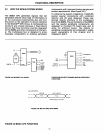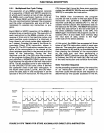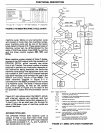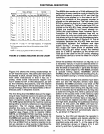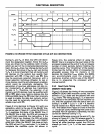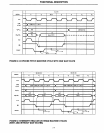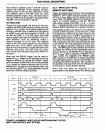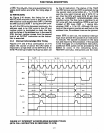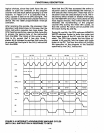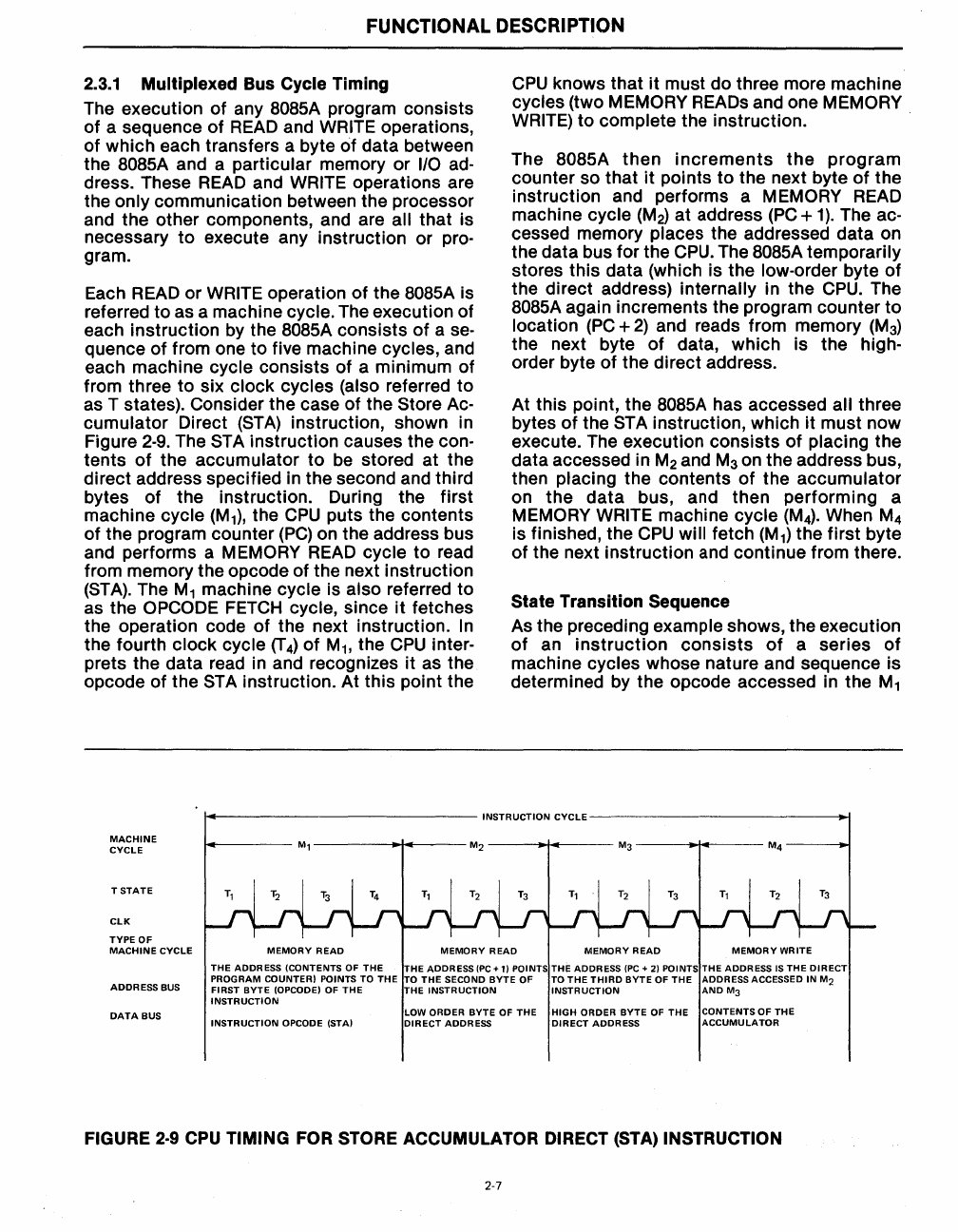
FUNCTIONAL DESCRIPTION
2.3.1
Multiplexed Bus Cycle Timing
The execution
of
any 8085A program consists
of a sequence
of
READ
and WRITE operations,
of which each transfers a byte
of
data between
the
8085A and a particular memory or
1/0
ad-
dress. These
READ
and WRITE operations are
the
only communication between the processor
and the other components, and are
all that is
necessary
to
execute any instruction or pro-
gram.
Each
READ
or WRITE operation
of
the 8085A is
referred
to
as a machine cycle. The execution of
each instruction by the
8085A consists
of
a
se-
quence
of
from one to five machine cycles, and
each machine
cycle consists
of
a minimum of
from three
to
six clock cycles (also referred
to
as T states). Consider the case
of
the Store Ac-
cumulator
Direct
(STA)
instruction, shown in
Figure
2-9. The STA instruction causes the con-
tents
of
the accumulator
to
be
stored at the
direct address specified in the second and third
bytes
of
the instruction. During the
first
machine cycle
(M
1
),
the
CPU
puts the contents
of
the program counter
(PC)
on the address bus
and performs a
MEMORY
READ
cycle to read
from memory the opcode
of
the next instruction
(STA).
The
M1
machine cycle is also referred
to
as the OPCODE
FETCH
cycle, since
it
fetches
the operation code
of
the next instruction.
In
the fourth clock cycle (T
4)
of
M
1
, the
CPU
inter-
prets the data read in and recognizes
it
as the
opcode of the
STA instruction. At this point the
CPU
knows that
it
must do three more machine
cycles (two MEMORY READs and one MEMORY
WRITE)
to complete the instruction.
The
8085A
then
increments
the
program
counter so that
it
points
to
the next byte
of
the
instruction and performs a
MEMORY READ
machine
cycle
(M
2
) at address
(PC
+ 1). The ac-
cessed memory places the addressed data on
the data bus for the
CPU.
The 8085A temporarily
stores this data (which is the low-order byte
of
the direct address) internally in the
CPU.
The
8085A again increments the program counter
to
location
(PC
+ 2) and reads from memory
(M3)
the next byte
of
data, which is the high-
order byte
of
the direct address.
At this point, the
8085A has accessed all three
bytes
of
the STA instruction, which it must now
execute. The execution consists
of
placing the
data accessed in
M2
and
M3
on the address bus,
then
placing the contents
of
the accumulator
on the
data
bus, and then performing a
MEMORY WRITE machine cycle
(M4).
When
M4
is finished, the
CPU
will fetch
(M
1
) the
first
byte
of
the next instruction and continue from there.
State Transition Sequence
As the preceding example shows, the execution
of
an
instruction
consists
of
a series
of
machine cycles whose nature and sequence is
determined by the opcode accessed in the
M1
~------------
INSTRUCTION
CYClE--------------.I
MACHINE
CYCLE
T
STATE
ClK
TYPE
OF
MACHINE
CYCLE
ADDRESS
BUS
MEMORY
READ
MEMORY
READ
MEMORY
READ
MEMORY
WRITE
THE
ADDRESS
(CONTENTS
OF
THE
THE
ADDRESS
(PC+ 1) POINTS
THE
ADDRESS
(PC
+ 2) POINTS THE
ADDRESS
IS
THE
DIRECT
PROGRAM
COUNTER)
POINTS
TO
THE
TO
THE
SECOND
BYTE
OF
TO
THE
THIRD
BYTE
OF
THE
ADDRESS
ACCESSED
IN
M2
FIRST
BYTE
(OPCODE) OF
THE THE
INSTRUCTION INSTRUCTION
AND
M3
INSTRUCTION
DATA
BUS
lOW
ORDER
BYTE
OF
THE
HIGH
ORDER
BYTE
OF
THE
CONTENTS
OF
THE
INSTRUCTION
OPCODE (STA)
DIRECT
ADDRESS
DIRECT
ADDRESS
ACCUMULATOR
FIGURE
2·9
CPU
TIMING
FOR
STORE
ACCUMULATOR DIRECT
(STA)
INSTRUCTION
2-7





